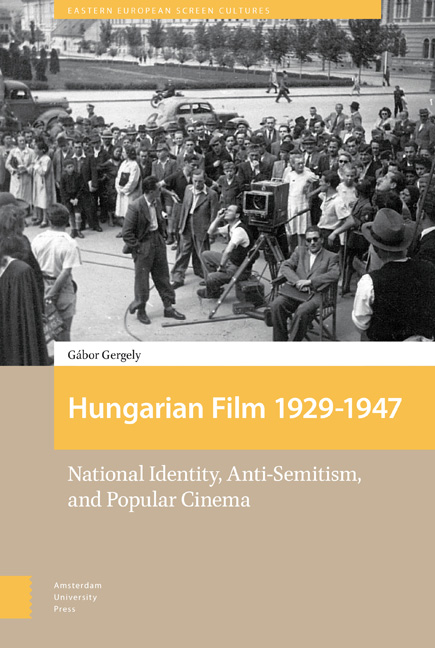Book contents
- Frontmatter
- Dedication
- Contents
- List of Illustrations
- Acknowledgements
- A Note on Accents, Pronunciation, Names, and Spellings
- Preface
- Introduction
- 1 Key Concepts in Pre-1945 Hungarian Cinema
- 2 A Contested Film History
- 3 An Industry Emerges 1931-1935
- 4 Boom, Crisis and Anti-Semitic Reorganization 1936-1941
- 5 From War Boom to Bust 1941-1944
- Epilogue: Industry Reboot and the Myth of a New Start 1945-1947
- Concluding Remarks
- Bibliography
- Index
Epilogue: Industry Reboot and the Myth of a New Start 1945-1947
Published online by Cambridge University Press: 11 December 2020
- Frontmatter
- Dedication
- Contents
- List of Illustrations
- Acknowledgements
- A Note on Accents, Pronunciation, Names, and Spellings
- Preface
- Introduction
- 1 Key Concepts in Pre-1945 Hungarian Cinema
- 2 A Contested Film History
- 3 An Industry Emerges 1931-1935
- 4 Boom, Crisis and Anti-Semitic Reorganization 1936-1941
- 5 From War Boom to Bust 1941-1944
- Epilogue: Industry Reboot and the Myth of a New Start 1945-1947
- Concluding Remarks
- Bibliography
- Index
Summary
Green Shoots
As suddenly as the industry had ground to a halt in late autumn 1944, so quickly it seemed to start up again. New initiatives were put in place to kick-start film production in early 1945. New directors were appointed to head the two state-owned production facilities and a new free trade union of actors, the Színészek Szabad Szakszervezete was established. By year's end, three films were in the can: Hazugság nélkül/Without Lies (Viktor Gertler, 1945), A tanítónő/The Tutoress (Márton Keleti, 1945), and Aranyóra/Gold Watch (Ákos Ráthonyi, 1945). However, as the familiar names above indicate, we have to talk of a qualified continuity, rather than a clean break.
As Deák et al. write in their book on postwar retribution in Europe:
One of the defects of European historiography, as it reflected the post-World War II settlement, was a marked inclination to separate the past from the present, as though 1945 was a true Year Zero and nothing that had gone before counted in the experience of what would come after. We can now see that this was patently false, albeit convenient and perhaps even helpful in the rebuilding of the continent
2000, xiThis is particularly apt for Hungarian film historiography, which has followed the Nemeskürty line: ‘Liberation was a milestone in Hungarian film history,’ he declared in Word and Image (1974, 141). He went on: ‘Béla Balázs came home, founded a journal, gave lectures, and began to teach the new public how to look at films, and new creative teams how to make films, training the first students of film production after 1945, who were to direct their first films in the [1950s]’ (Nemeskürty 1974, 141). The idea of a new public is hair-raising, indeed, and hardly needs any detailed dissection. The only thing that was new about the public was that it now excluded the victims of the recent war and the Holocaust. However, just as the public was the same, so too, the creative teams were largely unchanged. Ákos D Hamza was appointed director of Magyar Filmiroda (Fényszóró 1945. 3, 17).
- Type
- Chapter
- Information
- Hungarian Film, 1929–1947National Identity, Anti-Semitism and Popular Cinema, pp. 297 - 312Publisher: Amsterdam University PressPrint publication year: 2017



